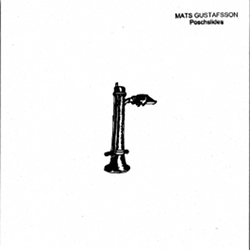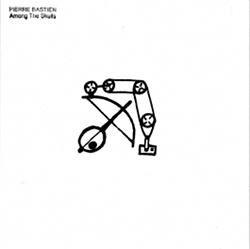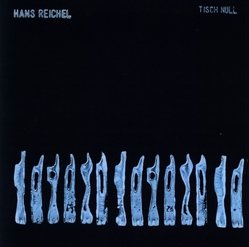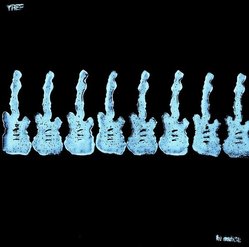ONE is a series of split 7-inches, featuring two artists or bands per record. The only condition enposed on the artists by the label is to use only one instrument as a source. It doesn't matter if it's played live or overdubbed on many tracks. Each cover is hand-printed with special stamps. The artworks were made up by the artists themselves. Each single is limited to 300 units.
out now
- MATS GUSTAFSSON vs. PIERRE BASTIEN cat.no.: ONE series #7
format: 7inch (split-single)
instruments: slide-saxophon, godje
-
MATS GUSTAFSSON
"Poschslides"
slide-saxophone
The swedish saxophonist Mats Gustafsson, perhaps more than any other musician in his field, epitomizes a hard percussive sound. What he does goes way beyond freejazz; he has played with the likes of Peter Brötzmann, Sonic Youth, Merzbow, Jim O'Rourke, Otomo Yoshihide and many more. He is an uncompromising improviser who never "merely" operates his instrument, be it soprano, tenor or alto-saxophon. His playing always involves an extremely physical use of the whole body. Through Gustafsson the saxophone seems to breath, sigh, scream and dribble. For the ONE-7inch series this exceptional saxophonist has allowed the slide-sax to lead a life of its own. This unusual instrument works in a similar way to a slide whistle and is something of a curiosity in the world or saxophones. The slide-saxophone was invented in the early twentieth century and was only ever produced by a few manufacturers, notably Swanee and Reiffel & Husted.
Mats Gustafsson was born 1964 in Umeå, Northern Sweden. Saxplayer, improviser and composer. Soloartist and international tours and projects.1500 concerts and over 140 recordproductions in Europe, North America and Asia. Collaborations with contemporary dance, theater, art as well as projects with noise, electronica, contemporary rock and free jazz. Producer of international festivals and concert tours as well as work with own record labels Slottet, OlofBright Editions and Blue Tower Records.
http://www.matsgus.com

-
PIERRE BASTIEN
"Among The Skulls"
godje
The instrument heard in this piece is a godji or godje: a monocord violin made of a calabash covered with the skin of a large lizard and fitted with a wood neck and a string made of horsehair. Anthropologist Paul Stoller explains that "the godji's sound links the Songhay present and past". A film by Jean Rouch shows the instrument played to call forth the spirits who will bring rain. Under the sky of the Netherlands I use to play the godje and it brings rain indeed. It also links me to the musicians present and past who favor the ancient sound of the violin before it was changed into a Western instrument. It connects me with the origins of music and rhapsody. Is it because of the round calabash and the horsehair reminding me of a skull? I named the piece "Among The Skulls" reminiscing of a chapter in The Palm Wine Drinkard by Nigerian writer Amos Tutuola, when the hero is imprisoned by a group of living skulls in a cave.
Pierre Bastien, March 2010
Pierre Bastien (born Paris, 1953) is a French musician. He currently lives in Rotterdam. He has built several automatic orchestras. Bastien always performs his concerts along with the last version of his many contraptions. The previous versions have a second life -though not virtual- as sound sculptures and installations. His collaborations include film maker Karel Doing, fashion design company Issey Miyake inc., video artist Pierrick Sorin, musicians Pascal Comelade, Robert Wyatt, Alexei Aigui, Steve Argüelles, choreographers Dominique Bagouet, Roberto Olivan, circus company Trottola and juggler Jérôme Thomas. His music is released on Gazul, G33G, Inpolysons, Signature, Rephlex, Western Vinyl.
http://www.pierrebastien.com

out before
- HANS REICHEL vs. FRANZ HAUTZINGER cat.no.: es-11 / ONE series #6
format: 7inch (split-single)
instruments: daxophon, trumpet
-
HANS REICHEL
"Tisch Null"
Daxophon
Wuppertal-based guitarist, violinist, instrument maker and typographer HANS REICHEL lives up to his myriad talents like few others. Starting out as a beat musician, he soon gained renown as Germany's "guru of experimental guitar". Today, he is often put into the wide category of "free jazz and improv". With the invention of the "daxophon", the most versatile musician and composer created hitherto unheard sounds. The instrument consists of an accumulation of fragile pieces of wood, which are bowed like a violin. Due to their potential for modulation and the timbre of the sounds emanating from it, it bears a great similarity to the human voice. With "Tisch Null", Reichel - who has composed entire operas for the daxophon and has become world famous for its invention - has recorded an exclusive daxo-piece for emphase records. With its complex polyphony, its bouncing rhythm and its wonderfully off-key humor, "Tisch Null" is, well, typically Hans Reichel. Apart from that, one simply cannot compare it to anything else.

-
FRANZ HAUTZINGER
"Duckdate"
Quarter Tone Trumpet
FRANZ HAUTZINGER is one of the most enigmatic musicians Austria has ever produced. The studied trumpeter (who has also graduated in composition) gained a solid reputation not only as a soloist but also through his may collaborations with colleagues such as Elliott Sharp, John Cale, Christian Fennesz, Otomo Yoshihide, Phil Niblock, Derek Bailey and John Tilbury (to name but a few). Although he spent his formative years as instrumentalist within the field of contemporary jazz, in recent years Hautzinger has developed an idiosyncratic and distinct instrumental voice which has been inspired in part by his inclination towards what is commonly called "contemporary music".
The piece for trumpet with the onomatopoetic (and refreshingly unacademic) title "Duckdate" has been produced by Franz Hautzinger exclusively for emphase records. Here, Hautzinger works with sounds, textures and intervals in a highly consistent way. This piece (which makes use of multitrack recording) fathoms the space with quaking and croaking sounds made by fluttering valves and sensual embrochure sounds. "Duckdate" fascinates through its very physical sound works and a spatiality, which can almost be grasped with one's hands.

- VERT vs. ACOUSTIC-INTERFACE cat.no.: es-06 / ONE series # 5
format: 7inch (split-single)
instruments: Piano, Calliope / Grinder Organ
-
VERT
"Octatone Rag"
Composer and programming virtuoso VERT is quickly increasing in popularity. His remake of Keith Jarret's legendary 'Köln Concert' is a classic in its own right. Since the release of the new Vert album 'nine types of ambiguity' on Mouse On Mars' label sonig this englishman is en vogue. Vert recorded a piece with prepared piano exclusively for the emphasolo series. It is played completely live, without any programming or overdubbing. Vert called it octatone rag for two reasons: it uses a scale called the octatonic scale and it reminded him of ragtime, particularly in the first part. The octatonic scale was invented (discovered? popularised?) by Olivier Messiaen, it's one of what he called the 'modes of limited transposition'. The middle section of the 'octatone rag' uses prepared notes, which means that Vert had stuck objects between the strings to change the timbre. This technique was invented (discovered? popularised?) by John Cage when he realised that he couldn't fit an entire percussion ensemble onto a stage. Vert used screws, bits of eraser and keyrings. Oh, and the creaking noise is one of the pedals.

-
ACOUSTIC INTERFACE
"Calliope"
ACOUSTIC INTERFACE aka Andreas Lubich is known as one quarter of ALBOTH. Andreas had the fortunate opportunity to record a manipulated Calliope (or Grinder Organ) during a visit in New York. The player was apparently unhappy when he found that somebody was recording his music, so he tried everything to destroy the songs his instrument normally plays. So what you hear is not the result of Andreas' mastering - it is absolutely live! It might have been because of the nasty weather that the player was in such a bad mood. His merry-go-round was deserted; only few children and of course Andreas witnessed this spectacular performance. Did you know that a Calliope (or Grinder Organ) can play two songs at the same time? Or hold one tone for about 30 seconds?

- STEPHAN MEYER vs. GUIDO MÖBIUS cat.no.: es-05 / ONE series #4
format: 7inch (split-single)
instruments: PS-55 Portasound, Jew's Harp
-
STEPHAN MEYER
"PS-55"
STEPHAN MEYER - a man and his Yamaha PS-55 Portasound-Keyboard. Funny lo-fi grooves recorded on 4-track. File under cheapo plastic organ trash. No programming, all played live. Stephan obviously likes the drum-presets, his distortion pedal and the arpeggio-function of his instrument. And he definitely rocks this Portasound!

-
GUIDO MÖBIUS
"Jew's Harp"
GUIDO MÖBIUS, the guy who runs the emphase label, discovered this track by accident on a CDR that Stephan recorded for a friend in Berlin. 'Jew's Harp' is Guido's reaction to (or answer on) 'PS-55'. Like Stephan's piece it is quite driving, but it sounds less harsh. Guido played with the percussive qualities of the Jew's Harp, developing polyrhythmical structures. He didn't use much filters or other mixing-tools; the frequency sweeps that can be heard mostly are the 'natural' results of time stretching and pitching. An amazing variety of sounds!

- HARALD "SACK" ZIEGLER vs. SONDERFELD cat.no.: es-04 / ONE series #3
format: 7inch (split-single)
instruments: Horn, Accordeon
-
HARALD "SACK" ZIEGLER
"September Horn"
Horn
Harald "Sack" Ziegler has always worked against his increasing popularity. It's impossible to describe the personality of this renaissance man in a few sentences. His name has become a trademark which, oddly, he shows no desire to market. In his wonderfully inspired autumn lullaby September Horn, Ziegler demonstrates his prowess on French horn, an instrument few people know that he studied. In this track, melodies, chords and sounds slowly are faded into each other. Compared with 200 Accordèons this piece sounds light and airy, although a slow bass-figure keeps on marching through it. But both tracks muster a unique intensity.

-
SONDERFELD
"200 Accordéons"
Accordeon
Sonderfeld is an idiosyncratic German band lead by Tom Waits incarnation Norbert Sonderfeld. The group has established their unique style with several releases on Veracity and Moloko Plus. Always open for musical experiments, Sonderfeld recorded a track for Vol.3 of the ONE series. 200 Accordéons is obviously influenced by the first two ONE series releases' minimalism, but the band charges this minimalism with the deepness of the accordions' sound. We are lucky that three of the four members of Sonderfeld play this instrument, so they were able to record this track live.

- YREF vs. WILBERG cat.no.: es-03 / ONE series #2
format: 7inch (split-single)
instruments: Guitar, Glockenspiel
-
YREF
"La Salida"
Guitar
In la salida (the journey) the Berlin-based guitarist and performance-artist Rainer Frey (aka "YREF") created a very concentrated, trance-like guitar piece. YREF freed the word 'trance' from the weight of all cliches and reduced it to it's pure meaning: the irresistible groove. The piece derives its energy from subtle changes in it's flowing movement. No overdubs were needed; this track was played live with a delay-effect. Rainer Frey has worked as a (solo-)artist for more then twenty years. In several theatre-projects and in bands like Monoblock, his unique musical style has been an essential ingredient.

-
WILBERG
"Professor Stabroth macht ein Nickerchen (im Zug nach Bamberg)"
Glockenspiel
Professor Stabroth macht ein Nickerchen (im Zug nach Bamberg) is a slowly flowing glockenspiel piece, devoid of any rhythmical meter. It sounds like it's title, which translates to "Professor Stabroth takes a nap on the train to Bamberg". Bernd Wilberg plays with the sound qualities of the glockenspiel: a long sustain and percussive character. The result could be described as nervous meditation. Professor Stabroth is a perfect response to the other piece: opposite in some ways, but concerned with some of the same topics. Bernd Wilberg is known as one part of the cologne electroacoustic duo Schmitz und Niebuhr.

- MINIKLON vs. F.S.BLUMM cat.no.: es-02 / ONE series #1
format: 7inch (split-single)
instruments: Farfisa, Mbira
-
MINIKLON
"1,5 Farfisa"
Farfisa
After the release of 40 Sekunden ohne Gewicht, emphase is proud to present this first miniklon-release. 1,5 Farfisa was composed and recorded by miniklon-member Dirk Specht. In fact he used only one Farfisa, but several distortion- and compression-effects. That's why Specht decided to name his piece 1,5 Farfisa. He created a hypnotic track with a deep, heartbeatlike groove. It contrasts with 6 Mbiras in many ways, but like this it's overtones provide a subtle deepness.

-
F.S.BLUMM
"6 Mbiras"
Mbira
Musician and sound-artist Frank Schültge aka F.S.Blumm works and releases with countless musical projects on labels like Morr, Gefriem, Tom, Staubgold, Plattenmeister and others. Definitely Blumm reached an underground cult-status in Germany already. Blumm composed 6 Mbiras as an answer to 1,5 Farfisa: "Now my job - introducing the instrument according to its inherent nature and, at the same time, empathizing with "1.5 Farfisa" - was not hard, because the automatic expression which arises when I play the Mbira has mostly a repetitive and minimal-music-like gesture." Another reference is -not only by name-: "Six Marimbas", a piece by Steve Reich.

point of contact
-
guido (at) autopilotmusic.com